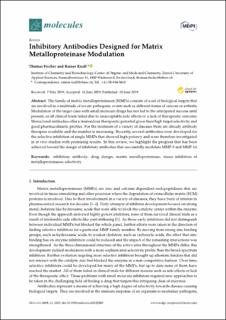Please use this identifier to cite or link to this item:
https://doi.org/10.21256/zhaw-19484Full metadata record
| DC Field | Value | Language |
|---|---|---|
| dc.contributor.author | Fischer, Thomas | - |
| dc.contributor.author | Riedl, Rainer | - |
| dc.date.accessioned | 2020-02-19T14:23:33Z | - |
| dc.date.available | 2020-02-19T14:23:33Z | - |
| dc.date.issued | 2019 | - |
| dc.identifier.issn | 1420-3049 | de_CH |
| dc.identifier.issn | 1433-1373 | de_CH |
| dc.identifier.uri | https://digitalcollection.zhaw.ch/handle/11475/19484 | - |
| dc.description.abstract | The family of matrix metalloproteinases (MMPs) consists of a set of biological targets that are involved in a multitude of severe pathogenic events such as different forms of cancers or arthritis. Modulation of the target class with small molecule drugs has not led to the anticipated success until present, as all clinical trials failed due to unacceptable side effects or a lack of therapeutic outcome. Monoclonal antibodies offer a tremendous therapeutic potential given their high target selectivity and good pharmacokinetic profiles. For the treatment of a variety of diseases there are already antibody therapies available and the number is increasing. Recently, several antibodies were developed for the selective inhibition of single MMPs that showed high potency and were therefore investigated in in vivo studies with promising results. In this review, we highlight the progress that has been achieved toward the design of inhibitory antibodies that successfully modulate MMP-9 and MMP-14. | de_CH |
| dc.language.iso | en | de_CH |
| dc.publisher | MDPI | de_CH |
| dc.relation.ispartof | Molecules | de_CH |
| dc.rights | http://creativecommons.org/licenses/by/4.0/ | de_CH |
| dc.subject | Drug design | de_CH |
| dc.subject | Inhibitory antibody | de_CH |
| dc.subject | Matrix metalloproteinase | de_CH |
| dc.subject | Selectivity | de_CH |
| dc.subject | Tissue inhibitors of metalloproteinase | de_CH |
| dc.subject | Amino acid sequence | de_CH |
| dc.subject | Animal | de_CH |
| dc.subject | Monoclonal antibody | de_CH |
| dc.subject | Binding site | de_CH |
| dc.subject | Human | de_CH |
| dc.subject | Matrix metalloproteinase inhibitors | de_CH |
| dc.subject | Molecular conformation | de_CH |
| dc.subject | Molecular docking simulation | de_CH |
| dc.subject | Molecular dynamics simulation | de_CH |
| dc.subject | Protein binding | de_CH |
| dc.subject | Structure-activity relationship | de_CH |
| dc.subject.ddc | 571: Physiologie und verwandte Themen | de_CH |
| dc.title | Inhibitory antibodies designed for matrix metalloproteinase modulation | de_CH |
| dc.type | Beitrag in wissenschaftlicher Zeitschrift | de_CH |
| dcterms.type | Text | de_CH |
| zhaw.departement | Life Sciences und Facility Management | de_CH |
| dc.identifier.doi | 10.3390/molecules24122265 | de_CH |
| dc.identifier.doi | 10.21256/zhaw-19484 | - |
| dc.identifier.pmid | 31216704 | de_CH |
| zhaw.funding.eu | No | de_CH |
| zhaw.issue | 12 | de_CH |
| zhaw.originated.zhaw | Yes | de_CH |
| zhaw.pages.start | 2265 | de_CH |
| zhaw.publication.status | publishedVersion | de_CH |
| zhaw.volume | 24 | de_CH |
| zhaw.publication.review | Peer review (Publikation) | de_CH |
| zhaw.webfeed | CC Drug Discovery | de_CH |
| zhaw.author.additional | No | de_CH |
| Appears in collections: | Publikationen Life Sciences und Facility Management | |
Files in This Item:
| File | Description | Size | Format | |
|---|---|---|---|---|
| 2019_Fischer_Inhibitory-antibodies.pdf | 2.82 MB | Adobe PDF |  View/Open |
Show simple item record
Fischer, T., & Riedl, R. (2019). Inhibitory antibodies designed for matrix metalloproteinase modulation. Molecules, 24(12), 2265. https://doi.org/10.3390/molecules24122265
Fischer, T. and Riedl, R. (2019) ‘Inhibitory antibodies designed for matrix metalloproteinase modulation’, Molecules, 24(12), p. 2265. Available at: https://doi.org/10.3390/molecules24122265.
T. Fischer and R. Riedl, “Inhibitory antibodies designed for matrix metalloproteinase modulation,” Molecules, vol. 24, no. 12, p. 2265, 2019, doi: 10.3390/molecules24122265.
FISCHER, Thomas und Rainer RIEDL, 2019. Inhibitory antibodies designed for matrix metalloproteinase modulation. Molecules. 2019. Bd. 24, Nr. 12, S. 2265. DOI 10.3390/molecules24122265
Fischer, Thomas, and Rainer Riedl. 2019. “Inhibitory Antibodies Designed for Matrix Metalloproteinase Modulation.” Molecules 24 (12): 2265. https://doi.org/10.3390/molecules24122265.
Fischer, Thomas, and Rainer Riedl. “Inhibitory Antibodies Designed for Matrix Metalloproteinase Modulation.” Molecules, vol. 24, no. 12, 2019, p. 2265, https://doi.org/10.3390/molecules24122265.
Items in DSpace are protected by copyright, with all rights reserved, unless otherwise indicated.